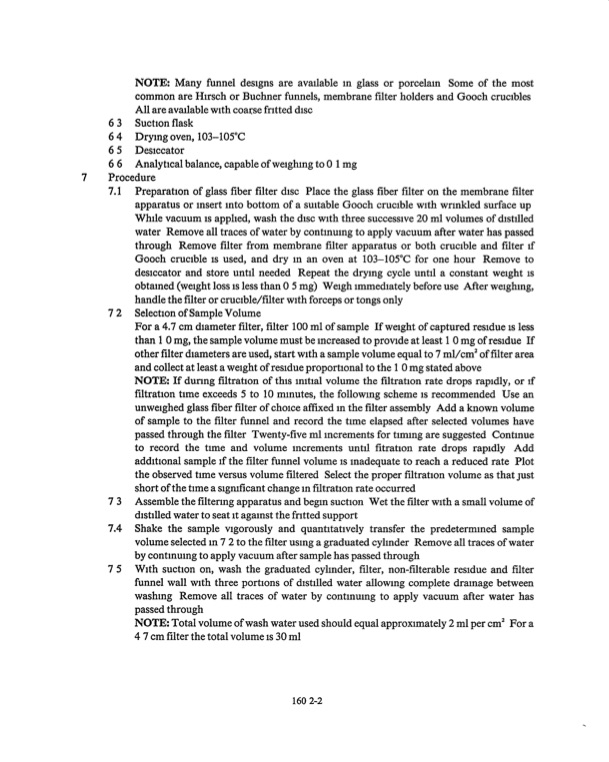
PDF Publication Title:
Text from PDF Page: 060
6 3 6 4 6 5 6 6 NOTE: Many funnel desIgns are available In glass or porcelaIn Some of the most common are HIrsch or Buchner funnels, membrane filter holders and Gooch crucIbles All are available wIth coaJ;:se fntted dISC SuctIon flask DryIng oven, 103-105°C DesIccator AnalytIcal balance, capable of weIghIng to 0 1 mg 7 Procedure 7.1 Preparation of glass fiber filter dISC Place the glass fiber filter on the membrane filter apparatus or Insert Into bottom of a sUItable Gooch crucIble with wrInkled surface up WhIle vacuum IS apphed, wash the diSC with three successive 20 ml volumes of distIlled water Remove all traces of water by contInuIng to apply vacuum after water has passed through Remove filter from membrane filter apparatus or both crucible and filter If Gooch crucible IS used, and dry In an oven at 103-105°C for one hour Remove to desiccator and store untIl needed Repeat the dryIng cycle untIl a constant weight IS obtaIned(weightlossISlessthan05mg) WeighImmediatelybeforeuse AfterweighIng, handle the filter or crucible/filter with forceps or tongs only 72 SelectIOn o f Sample V olume For a 4.7 cm diameter filter, filter 100 m1 of sample If weight of captured residue IS less than10mg,thesamplevolumemustbeIncreasedtoprovideatleast10mgofresidue If 2 otherfilterdiametersareused,startwithasamplevolumeequalto7mllcm offilterarea and collect at least a weight ofresidue proportIOnal to the 1 0 mg stated above NOTE: If dunng filtratIOn of this Initial volume the filtratIOn rate drops rapIdly, or If filtratIOn time exceeds 5 to 10 mmutes, the followmg scheme IS recommended Use an unwelghed glass fiber filter of chOIce affixed m the filter assembly Add a known volume of sample to the filter funnel and record the time elapsed after selected volumes have passed through the filter Twenty-five ml mcrements for tmung are suggested Contmue to record the time and volume mcrements until fitratIon rate drops rapidly Add additional sample If the filter funnel volume IS madequate to reach a reduced rate Plot the observed ttrne versus volume filtered Select the proper filtratIOn volume as that Just short ofthe tIme a significant change m filtratIOn rate occurred 73 Assemble the filtenng apparatus and begIn suction Wet the filter With a small volume of distilled water to seat It agamst the fntted support 7.4 Shake the sample vIgorously and quantitatively transfer the predetermmed sample volume selected m 7 2 to the filter USIng a graduated cylInder Remove all traces of water by contInumg to apply vacuum after sample has passed through 75 With suctIon on, wash the graduated cylInder, filter, non-filterable residue and filter funnel wall With three portIOns of distilled water allowmg complete draInage between washmg Remove all traces of water by contInuIng to apply vacuum after water has passed through 2 NOTE: Total volume ofwash water used should equal approximately 2 ml per cm 4 7 cm filter the total volume IS 30 ml For a 1602-2PDF Image | Methods for Chemical Analysis of Water and Wastes

PDF Search Title:
Methods for Chemical Analysis of Water and WastesOriginal File Name Searched:
epa600_4_79_020.pdfDIY PDF Search: Google It | Yahoo | Bing
CO2 Organic Rankine Cycle Experimenter Platform The supercritical CO2 phase change system is both a heat pump and organic rankine cycle which can be used for those purposes and as a supercritical extractor for advanced subcritical and supercritical extraction technology. Uses include producing nanoparticles, precious metal CO2 extraction, lithium battery recycling, and other applications... More Info
Heat Pumps CO2 ORC Heat Pump System Platform More Info
| CONTACT TEL: 608-238-6001 Email: greg@infinityturbine.com | RSS | AMP |